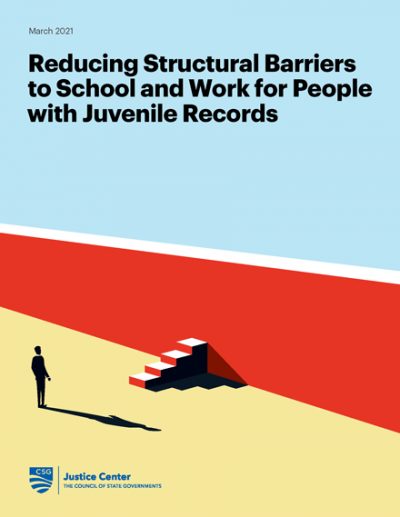Open to Interpretation
Some of the states studied expressly prohibit licensing boards from considering juvenile adjudications when they evaluate a person’s “moral character,” but the majority of states have no such restrictions.

This report — which can be downloaded or viewed online — explores how barriers to education and employment in 12 states are affecting people with juvenile justice system involvement. It is a first-of-its-kind analysis from The Council of State Governments Justice Center, with financial support from the Annie E. Casey Foundation.
A companion policy solutions tool kit offers sample legislative language to help states reduce structural barriers to school and work for people with juvenile records.
People with a juvenile record can face legal barriers that prevent them from continuing their education, earning credentials or obtaining meaningful employment
These consequences even apply to individuals who committed a minor offense like trespassing or a status offense — acts that are illegal only when committed by juveniles—such as truancy or breaking curfew.
People with juvenile records can also face long-term barriers to education and employment. These barriers disproportionately affect people of color due to persistent racial and ethnic disparities in rates of juvenile justice involvement.
While state statutes acknowledge the difference between juvenile adjudications and adult criminal convictions, state policies don’t effectively distinguish between the two and are often undermined by vague language, explicit exceptions or a lack of clear criteria. The issues with such ambiguity are particularly evident in instances where an individual’s “good moral character” or “fitness” requirements for a particular job or license are under review. Absent clear and specific language, decision makers may include juvenile records as part of their considerations.
The companion policy solutions tool kit provides sample legislative language to help states support second chances for people with juvenile records. It highlights five key areas where improvements in state policy can generate significant opportunities for people with juvenile records. Recommended improvements include: making juvenile records presumptively confidential, clearing records automatically without cost for most youth, and advising youth of the possible education and employment barriers that could result from a conviction. Policymakers can also use the tool kit to tailor solutions for their respective states and review best practice examples.
The simplest, most important step that state policymakers can take? Establish a comprehensive legal provision stating that juvenile adjudications cannot be used as the basis for education or employment decisions by employers, education institutions, and other public or private entities.